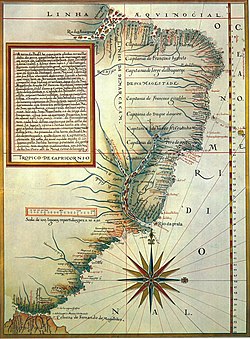
Portuguese colonization of the Americas constituted territories in the Americas belonging to the Kingdom of Portugal. Portugal was the leading country in the European exploration of the world in the 15th century. The Treaty of Tordesillas in 1494 divided the Earth outside Europe into Castilian and Portuguese global territorial hemispheres for exclusive conquest and colonization. Portugal colonized parts of South America, but also made some unsuccessful attempts to colonize North America.

The federative units of Brazil are subnational entities with a certain degree of autonomy and endowed with their own government and constitution, which together form the Federative Republic of Brazil. There are 26 states and one federal district. The states are generally based on historical, conventional borders which have developed over time. The states are divided into municipalities, while the Federal District assumes the competences of both a state and a municipality.
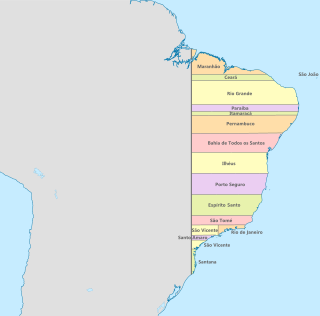
Colonial Brazil comprises the period from 1500, with the arrival of the Portuguese, until 1815, when Brazil was elevated to a kingdom in union with Portugal. During the 300 years of Brazilian colonial history, the main economic activities of the territory were based first on brazilwood extraction, which gave the territory its name; sugar production ; and finally on gold and diamond mining. Slaves, especially those brought from Africa, provided most of the workforce of the Brazilian export economy after a brief initial period of Indigenous slavery to cut brazilwood.
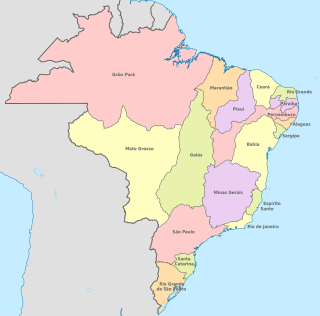
The Viceroyalty of Brazil refers, in narrow scope, to office of viceroy of the Portuguese colonial State of Brazil and, in broad scope, to the whole State of Brazil during the historic period when its governors had the title of "viceroy". The term "viceroyalty" however never officially designated the title of the colony, which continued to be designated "state". Until 1763, the title "Viceroy" was occasionally granted to some governors of Brazil who were members of the high nobility, with the remaining keeping the title "governor-general". From around 1763, the title "viceroy" became permanent, so being granted to all governors. The position of viceroy was abolished, when the Portuguese court transferred to Brazil in 1808, with the State of Brazil becoming directly administered by the Portuguese Government seated in Rio de Janeiro.

The Captaincies of Brazil were captaincies of the Portuguese Empire, administrative divisions and hereditary fiefs of Portugal in the colony of Terra de Santa Cruz, later called Brazil, on the Atlantic coast of northeastern South America. Each was granted to a single donee, a Portuguese nobleman who was given the title captain General.
A governorate or governate is an administrative division of a state that is headed by a governor. As English-speaking nations tend to call regions administered by governors either states or provinces, the term governorate is typically used to calque divisions of non-English-speaking administrations.
A donatary captain was a Portuguese colonial official to whom the Crown granted jurisdiction, rights and revenues over some colonial territory. The recipient of these grants was called a donatário (donatary), because he had been given the grant as a doação (donation) by the king, often as a reward for service.
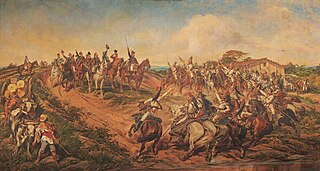
The independence of Brazil comprised a series of political and military events that led to the independence of the Kingdom of Brazil from the United Kingdom of Portugal, Brazil and the Algarves as the Brazilian Empire. It is celebrated on 7 September, the date when prince regent Pedro of Braganza declared the country's independence from the United Kingdom of Portugal, Brazil and the Algarves on the banks of the Ipiranga brook in 1822 on what became known as the Cry of Ipiranga. Formal recognition by Portugal came with the Treaty of Rio de Janeiro, signed in 1825.

The State of Brazil was one of the states of the Portuguese Empire, in the Americas during the period of Colonial Brazil.

The Governorate General of Rio de Janeiro was a colonial administration of the Portuguese Empire.

The Governorate General of Bahia was a colonial administration of the Portuguese Empire.

The Captaincy General of the Azores was a politico-administrative structure of governance imposed in the Azores on 2 August 1766, with its seat in Angra. It remained the de facto system of governance for 65 years, until it was abolished on 4 June 1832 by D. Peter IV, but by 1828 its de jure status had made it nonoperational, owing to the revolutionary movements that lead to the Liberal Wars. The creation of the Captaincy-General was part of the Pombaline reforms to the Portuguese administration, during the reign of Joseph I, under the initiatives of Sebastião José de Carvalho e Melo, 1st Marquis of Pombal, then prime minister. A Captaincy-General operated from the Palace of the Captains-General, under the direction of the titular Captain-General, who operated as the Governor of the Azores, with additional jurisdiction on every island of the Azorean archipelago. The Captaincy-General was succeeded by the Province of the Azores, an ephemeral administrative structure that was collapse in the immediate years.
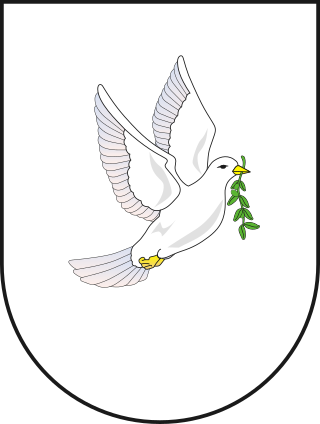
The Captaincy of Bahia, fully the Captaincy of the Bay of All Saints, was a captaincy of Portuguese Brazil.

Joaquim Xavier Curado, the first and only baron with greatness and count of São João das Duas Barras, also known as “the creator of the Brazilian army” and “the commander of the army of independence”, was a Brazilian military officer, nobleman and politician.

Forte de Santo Antônio da Barra is a fort located in Salvador, Bahia, Brazil. It was constructed to guard the entrance to the Bay of All Saints, during the time of the Portuguese Empire. The first Portuguese fortification erected in Bahia was likely built in 1501, in the same area now occupied by the Forte de Santo Antônio da Barra. The foundation stone of that first fortification was placed in an area called Ponta do Padrão, now known as the Largo do Farol da Barra, the broad public square in front of the fort. The fort also houses the 22 metres (72 ft)-high Barra Lighthouse and the Nautical Museum of Bahia. The Santo Antônio da Barra Fort is protected as a historic structures by the National Institute of Historic and Artistic Heritage.

The Royal Captaincy of São Paulo was one of the captaincies of Colonial Brazil. It received this name on December 2, 1720, when John V of Portugal created the Captaincy of Minas Gerais from the division of the Captaincy of São Paulo and Minas de Ouro, which had been created in 1709 with the purchase by the Portuguese crown of the Captaincy of São Vicente.

Conquista do Pará, also called the Império das Amazonas, now the Brazilian state of Pará, was an indigenous territory transformed into Portuguese colonial territory in 1615 by the military man and nobleman Alexandre de Moura, at the beginning of the colonization of the Amazon and conquest of the Amazon River. It was located in the then Captaincy of Maranhão (1534-1621).

The Captaincy of Rio Grande was one of the administrative subdivisions of Brazilian territory during the colonial period of Portuguese America. It was created in 1534 along with thirteen other hereditary captaincies and granted by John III, King of Portugal, to the so-called donatários. Initially, it was administered by João de Barros, a Portuguese historian, and Aires da Cunha.

The Captaincy of Itamaracá was one of the administrative subdivisions of Brazilian territory during the colonial period of Portuguese America. It was created in 1534 along with thirteen other hereditary captaincies and granted by John III, King of Portugal, to the so-called donatários. After being established, it was donated to Pero Lopes de Sousa.
